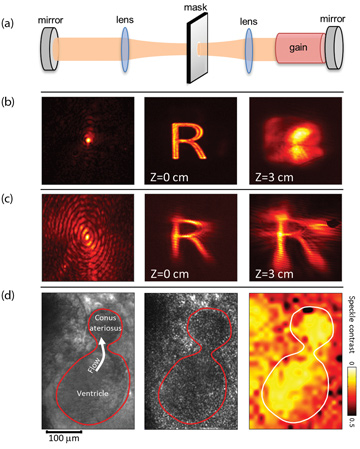 (a) Experimental arrangement of the modified degenerate cavity (MDC) laser. (b) A circular mask generates a Gaussian-like spatial coherence function (left), whereby beam shape and image are distorted after short free-space propagation distances (center and right). (c) An annular ring mask generates a shaped beam with a Bessel spatial coherence function (left), whereby beam shape is maintained even after long propagation distances (center and right). (d) Multimodal imaging of the heart of Xenopus embryo (tadpole). (Left) Speckle-free image with low-spatial-coherence illumination from the MDC shows the heart with outlines of ventricle and conus ateriosus. (Center) Speckled image with coherent illumination from the MDC. (Right) Spatially resolved speckle-contrast, obtained from speckled images, enables the characterization of blood flow.
(a) Experimental arrangement of the modified degenerate cavity (MDC) laser. (b) A circular mask generates a Gaussian-like spatial coherence function (left), whereby beam shape and image are distorted after short free-space propagation distances (center and right). (c) An annular ring mask generates a shaped beam with a Bessel spatial coherence function (left), whereby beam shape is maintained even after long propagation distances (center and right). (d) Multimodal imaging of the heart of Xenopus embryo (tadpole). (Left) Speckle-free image with low-spatial-coherence illumination from the MDC shows the heart with outlines of ventricle and conus ateriosus. (Center) Speckled image with coherent illumination from the MDC. (Right) Spatially resolved speckle-contrast, obtained from speckled images, enables the characterization of blood flow.
Spatial coherence, a fundamental property of light that contains spatial information, can influence many applications. For example, spatially coherent light contributes to speckle noise and, consequently, to low quality in imaging and display applications. Control of spatial coherence can suppress speckle noise, improve image quality and overcome deleterious effects of propagation through random or turbulent media.
We recently showed that inserting an intra-cavity binary amplitude mask into degenerate cavity lasers with a large number of modes (typically 103-105) allows rapid and efficient tuning of the lasers’ degree of spatial coherence.1-3 The mask serves as a spatial filter that modifies the degenerate cavity laser by introducing loss to undesired modes. Tuning the degree of spatial coherence involves simply changing the mask geometry—significantly greater flexibility than for other recently developed spatially incoherent sources, such as D-shaped micro-cavity lasers, for which tuning is difficult.4
The number of modes in this modified degenerate cavity (MDC) can be varied over five orders of magnitude, while the output power of the laser remains essentially constant, and the functional form of the spatial coherence can be controlled.1,2 Special functional forms of the spatial coherence have a dramatic effect on propagation properties. For example, a Bessel spatial coherence function induces propagation invariance to any transverse distribution of light (that is, to any image).
For biomedical imaging in particular, the MDC can serve as a compact source for switching between coherent and incoherent illumination.5 The latter enables traditional low-speckle, high-speed video-microscopy, while the former allows extraction of dynamic information on flow processes, such as blood flow, using laser speckle contrast imaging.
Researchers
Ronen Chriki, Vishwa Pal, Chene Tradonsky, Gilad Barach, Asher A. Friesem and Nir Davidson, Weizmann Institute of Science, Rehovot, Israel
Sebastian Knitter, Changgeng Liu, Brandon Redding, Mustafa K. Khokha, Michael A. Choma and Hui Cao, Yale University, New Haven, Conn., USA
References
1. M. Nixon et al. Opt. Lett. 38, 3858 (2013).
2. R. Chriki et al. Opt. Express 23, 12989 (2015).
3. M. Nixon et al. Nat. Photon. 7, 919 (2013).
4. B. Redding et al. Proc. Natl. Acad. Sci. USA 112, 1304 (2015).
5. S. Knitter et al. Optica 3, 403 (2016).
